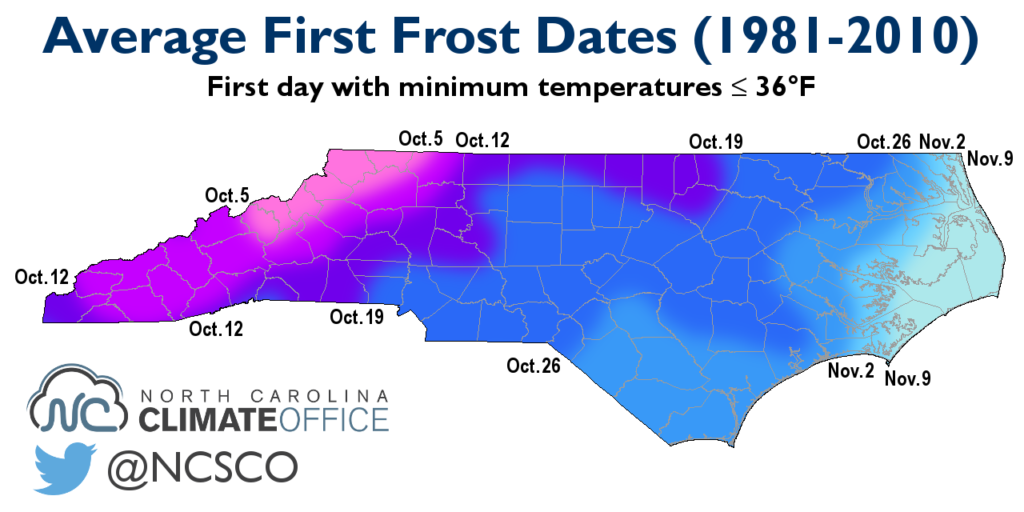Table Of Content

Charlotte has never had a freezing temperature before October. The earliest Charlotte dropped to freezing or below was the morning of Oct. 9, 2000, when Charlotte chilled down to 31 degrees. Learn how to protect your plants when frost is on its way. Here are the total inches it has snowed in Charlotte since 1880, per decade, according to the National Weather Service. Registering for this site allows you to access your order status and history.
How to Cold Stratify Seeds
Frost dates are calculated based on data from the NOAA National Centers for Environmental Information. A Hard Freeze Warning is issued when temperatures are expected to be 28°F or less. A Hard Freeze Watch may be issued a few days ahead of time if the potential exists for temperatures to fall into these thresholds. Below is a list of planting guides for Charlotte, NC.
Current Moon Phase
Deeper valleys tend to have frost conditions earlier than the surrounding area since cold air sinks. Want to know when to expect your last frost of the spring, or the first frost of the fall? Enter your zip code (or City, State) below and we'll tell you what we know. Our information is taken directly from the National Weather Service and depending on the location of the reporting station for your zip code, the results may vary. The growing season, however, can end early once the first hard freeze or "killing freeze" happens to the area.

When is the average last spring frost and first fall frost? We have dates for both, listed state by state.
A frost date is the average date of the last light freeze in spring or the first light freeze in fall. The dates provided are based on the number of weeks before or after frost, so we can provide a unique calendar to every user in the country. Thus, several crops (especially similar crops) may appear to have the same date. Kale and lettuce, for example, or dates for starting seeds, like broccoli and cabbage. In fact, many crops with short maturity times (such as radishes) can be succession planted all the way through the summer in northern areas.
Snow is most likely to fall in January, followed by February, December, and March. These include kale, cabbage, parsnips, carrots, beets, and brussels sprouts. Frosty weather helps the starch in the root turn to sugar so they taste sweeter. This brings the area's average first freeze to Nov. 8, but that window can be expanded from Nov. 1 to 10.
Seed Shelf Life Demystified: How Long Are Your Vegetable Seeds Good For?
You can learn more about this age-old technique below. The area has seen about 791.3 inches of snow since 1878, according to data from the National Weather Service, for an average of about 4.3 inches of snow between Oct. and May. Most vegetables and herbs need to be harvested before the first frost, which will turn them brown or mushy. A 29 to 32 degree frost may only damage the leaves, inhibiting their ability to photosynthesize. The second frost might not come for another few weeks allowing a little more harvest time. Below are images depicting the earliest, median, and the latest dates for the last 36°F Frost, 32°F, and 28°F freezes across our region.
WCNC would like to send you push notifications about the latest news and weather.
Below are images depicting the earliest, median, and the latest dates for the first 36°F Frost, 32°F, and 28°F freezes across our region. Freeze Warning/Watches and Frost Advisories will be issued during the beginning and the ending of the growing season. North Carolina has a range of climates spanning from as cold as Zone 6b to as warm as Zone 8b. — November has officially begun, and it started with a chill in the air. Now, it looks like this weekend, Charlotte is due for its first frost of the season. The planting calendar below tells you when to plant in the SPRING and also plant in the FALL, based on your zip code or postal code.
Ring in the holidays with Charlotte beers — including one naughty brewery - Charlotte Observer
Ring in the holidays with Charlotte beers — including one naughty brewery.
Posted: Fri, 19 Nov 2021 08:00:00 GMT [source]
The growing season
The changing color of leaves during fall is a completely separate phenomenon from the falling temperatures. Leaf color change is caused by the shortening of days from summer to fall. Interestingly, the brilliant fall color is there all summer, but until fall, it is hidden by the production of (green) chlorophyll. As days shorten in fall, leaves shut down their chlorophyll production, and their real pigments are revealed. These are averages so a frost could come a few weeks earlier or later than the stated dates.
Quick action by Frost and others saves man's life at airport - Lovell Chronicle
Quick action by Frost and others saves man's life at airport.
Posted: Thu, 19 Jul 2018 07:00:00 GMT [source]
These charts can help you estimate when to expect the first frost in fall, and the last frost in spring, so that you know when to plant in your garden or meadow. Our spring planting calendar starts with the very first dates that you can plant (based on the last spring frost). You can turn to a few different sources to determine the average frost dates in your area, as noted.
Here is some general info for USDA Zone 8a to help you get started.
Frost is predicted when air temperatures reach 32°F (0°C). Still, a frost may occur even when air temperatures are just above freezing due to open exposure to the clear night sky, which exposes surfaces to radiative cooling. Always keep an eye on your local weather forecast and plan to protect tender plants accordingly. Weather, topography, and microclimates may also cause considerable variations in the occurrence of frost in your garden. To ensure the safety of your tender plants and fall harvests, you might want to adjust the average frost dates that are published for your region. Consider planting two weeks later in spring and two weeks earlier for fall/winter to protect your plants from unexpected and abnormal cold temperatures.
The dates listed below are estimated average light frost dates based on historical data from the National Climatic Data Center. A light frost is when temperatures are between 29°–32°F. During a light frost, tender plants may be killed, with little destructive effect on hardier vegetation. Starting seeds indoors (in seed trays or starter pots) gives your crops a head start on the growing season, which is especially important in regions with a short growing season. Starting seeds indoors also allows young, tender plants to grow in a stable, controlled environment. Indoors, you can control these elements to maximize your plants' early growth and give them the best shot at thriving when they are transplanted outdoors.

Frost becomes more widespread when the temperature falls below 32°F with some freeze possible. A Freeze Watch may be issued a few days ahead of time if the potential exists for temperatures to fall into these thresholds. A Frost Advisory is issued when temperatures are forecast to be in the 33°F to 36°F range with good radiation conditions.

No comments:
Post a Comment